Diving into the golden era of style, 1950s men’s fashion epitomized a period of transition, elegance, and the birth of modern casual wear. This decade, post-World War II, was a time of economic boom and cultural shifts that significantly influenced how men dressed, both in their daily lives and on special occasions. 50s men’s fashion also laid a lot of the groundwork for style staples that still hang in people’s closets today.
However, the early years of the decade were a style desert, a buttoned-up hangover of rigid post-war conformity in which even the maddest of men were trapped in grey-suit lockdown; but a great loosening-up had begun to occur by the time the like of Brando roared into town.
Rock ‘n’ roll music, Beat poetry, and the abstract expressionists were leading the countercultural charge, and fashion took its cue from their let-it-all-hang-out ethos; cuts became looser, collars lost their starch, and elements of sportswear, workwear, and military uniform began to find their way into the everyday wardrobe.
This article delves deep into the essence of the era, exploring the fundamental pieces that defined men’s wardrobes and how these styles have left a lasting legacy on contemporary fashion. Keep reading to discover all that there is to know about men’s fashion in the 1950s.
Key Takeaways: What Is 1950s Men’s Fashion?
This was a time when some of today’s style staples – the turtleneck, the denim jacket , the knitted polo – were starting to come into their own, worn with an air of studied nonchalance, if not a sneer at the be-hatted corporate drones. But perhaps nothing symbolised the new, rebel-yell era more potently than the elevation of the humble white T-shirt.
Formerly a military-issue undergarment, it was suddenly draped across the decade’s most iconic chests; Brando got sweaty in one in 1951’s A Streetcar Named Desire, while James Dean brooded in one in Rebel Without A Cause (1955). Even Arthur Miller was pictured in one at his writing desk. “It became a kind of visual shorthand for rebellion,” says G. Bruce Boyer, fashion historian and author of True Style: The History and Principles of Classic Menswear, who was himself a teenager in the 1950s. “It represented the appropriation of blue-collar clothing for those who refused to buy into corporate society.”
Meanwhile, rockers like Elvis Presley left more formal dress codes, well, all shook up, replacing trilbies with slick quiffs, ties with button-down shirts, and fusty flannels with featherweight fleck-linen jackets. Jack Kerouac and the Beats made a fetish of utilitarian workwear, both in their lives – in their plaid shirts and beat-up blouson jackets – and in their literature: “His dirty work clothes clung to him so gracefully, as though you couldn’t buy a better fit from a custom tailor but only earn it from the Natural Tailor of Natural Joy,” writes Kerouac of Dean Moriarty (inspired by real-life Beat hipster Neal Cassady) in 1957’s On The Road.
Leading the pack of unruly artists, Jackson Pollock sported splattered denim overalls when creating his epoch-making drip paintings: “A lot of artists in the 1930s and 1940s dressed like accountants,” says Boyer. “Jackson and his peers wanted to look like the antithesis of that.” In their decisive break with sartorial tradition, the 1950s rebels found their ultimate – and most enduring – cause. “They broke the mould,” says Boyer. “And we’re continuing to live with their legacy.”
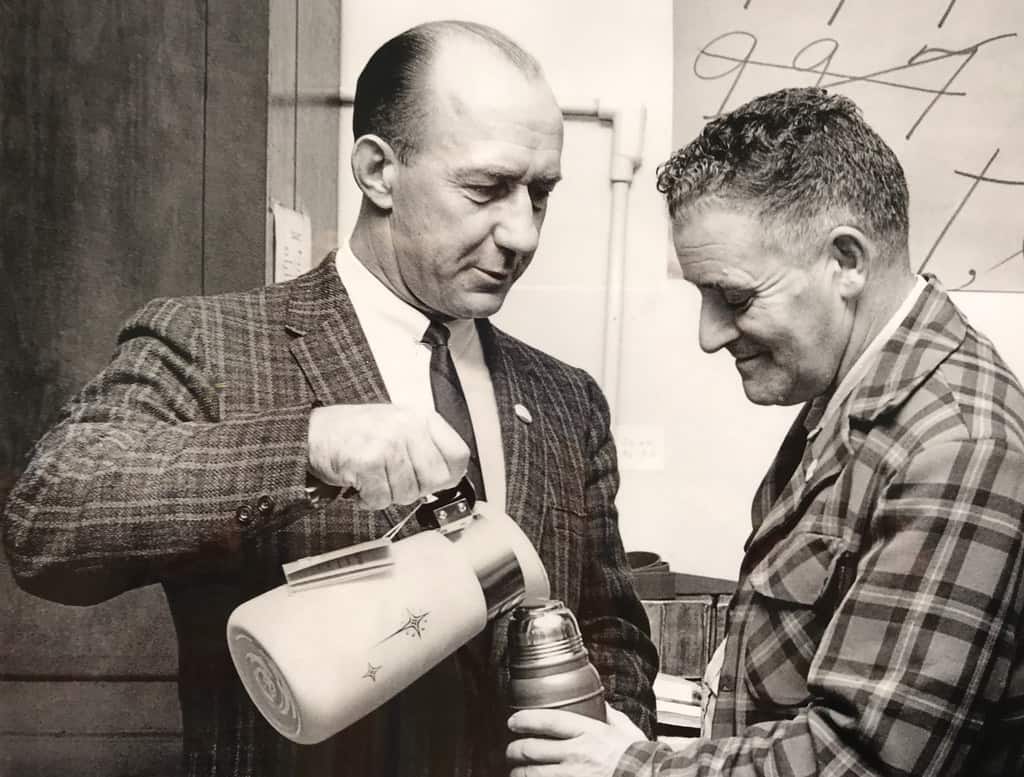
1950s Men’s Fashion: A Brief Background
The 1950s were a pivotal decade for men’s fashion, characterized by a mix of conservatism and flamboyance that reflected the post-war economic boom and the emerging youth culture. At the beginning of the decade, men’s fashion was heavily influenced by the austerity of the 1940s, with clothing that was functional and reserved. However, as the decade progressed, men’s fashion began to embrace more color, pattern, and casual styles, reflecting a society that was becoming increasingly affluent and leisure-oriented.
Hollywood actors like Marlon Brando and James Dean became style icons, influencing men’s fashion with their casual, rebellious looks, including leather jackets, jeans, and T-shirts. This decade also saw the rise of designer fashion in men’s wear, with designers like Christian Dior and Hubert de Givenchy beginning to influence men’s fashion choices.
Television and advertising became more prevalent, playing a crucial role in spreading fashion trends and creating a unified sense of style across the United States and beyond. The 1950s also marked the beginning of the Civil Rights Movement, which, while primarily a struggle for social justice, subtly influenced men’s fashion by beginning to challenge traditional norms of dress and grooming based on race and class.
Our Favorite 1950s Men’s Fashion Staples
Men’s Fashion in the 1950s: Style Essentials
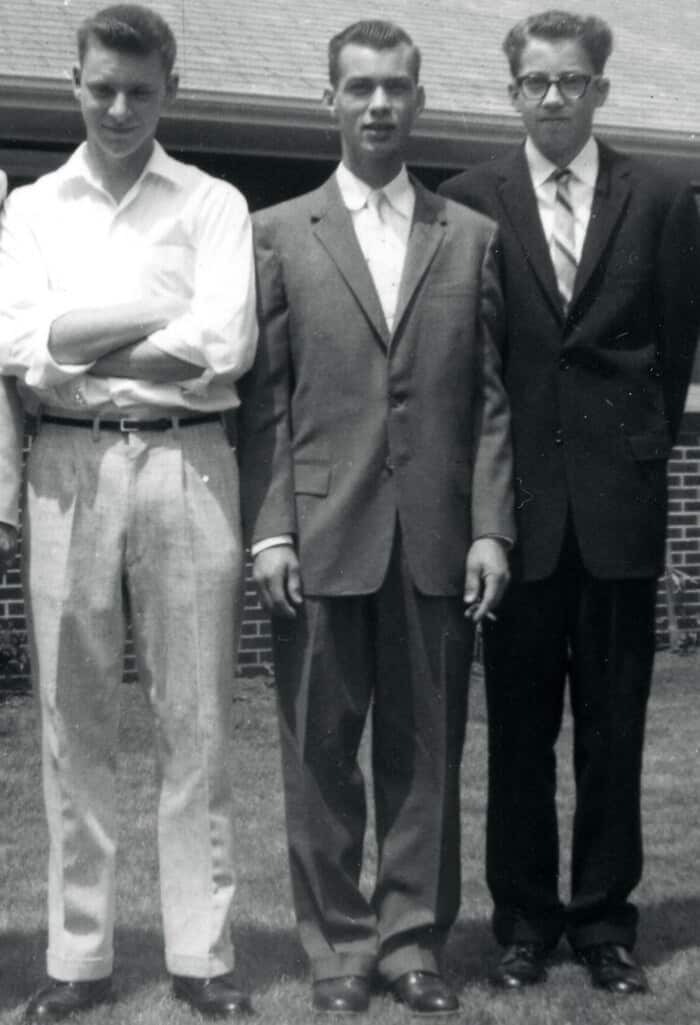
Suits
Suits in the 1950s were all about a masculine silhouette, with a clear emphasis on straight lines. The classic sack suit (think: looser jacket) was still popular in early 1950s male fashion. As the decade progressed, the straight sillouete remained but became slightly more form-fitting and slimmer than in earlier years, meaning shoulderpads used to create a more V-shaped torso in earlier years fell out of fashion.
The double breasted suit was very much still in vogue, but the single-breasted jackets with wider lapels and rounded points were largely becoming the norm. The Roman-style suit (invited by Brioni) also made its debut. Its biggest contribution to today’s style was the inclusion of side vents (one on each side of the hip) vs. the single back vent normal in the American sack suit.
Fabrics played a key role, while polyester had been invented in the 1940s, it really took off in 1950s men’s fashion. But wool, flannel, and ultra-luxurious mohair continued to be predominant choices for their durability and elegance. The color palette was relatively conservative, dominated by shades of grey, blue, and brown, though the end of the decade saw a gradual introduction of more vibrant colors and patterns.
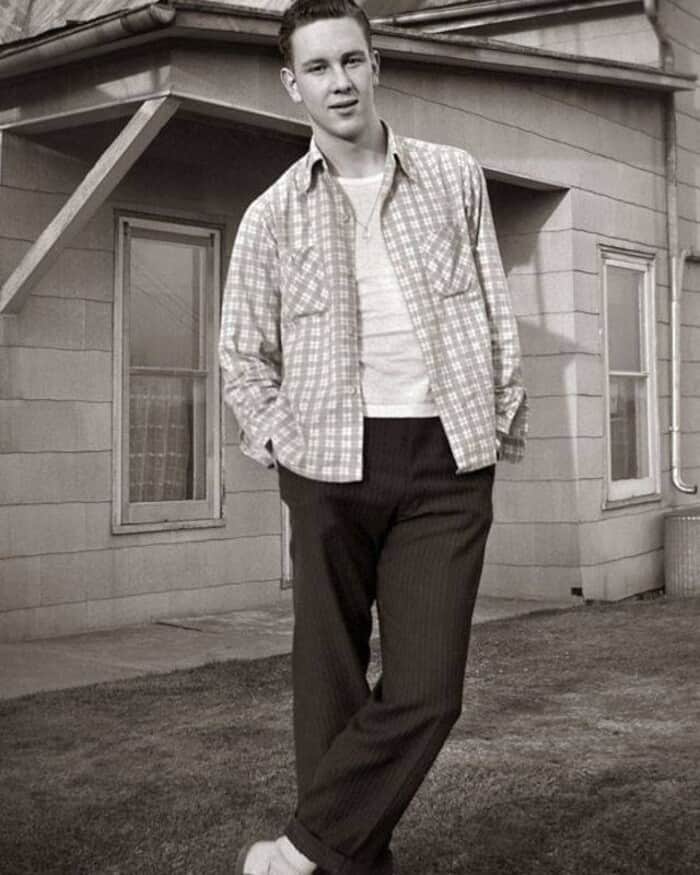
Shirts
Shirts in the early 1950s were typically made of cotton or linen and featured bold patterns and often loud colors. As the decade progressed, men’s 1950s fashion began to incorporate softer pastels – some argue this is to allow for louder and bolder ties. The most common styles were the shorter point collar and the spread collar, and the club collar (rounded edges) which were suitable for both formal and casual settings. Unlike the 1920s when detachable collars were the norm, the 1950s men’s fashion solidified the popularity of the attached collar – both for comfort and ease purposes.
1950s men’s fashion also saw the introduction of more casual shirt styles, including the polo shirt and the Cuban collar shirt, reflecting a growing interest in leisure and comfort.
Emulating the Hollywood superstars of the day, like Marlon Brando (specifically from his role in A Streetcar Named Desire in 1951), the plain t-shirt really began its reign during this decade – a casual wardrobe staple that remains popular to this day.
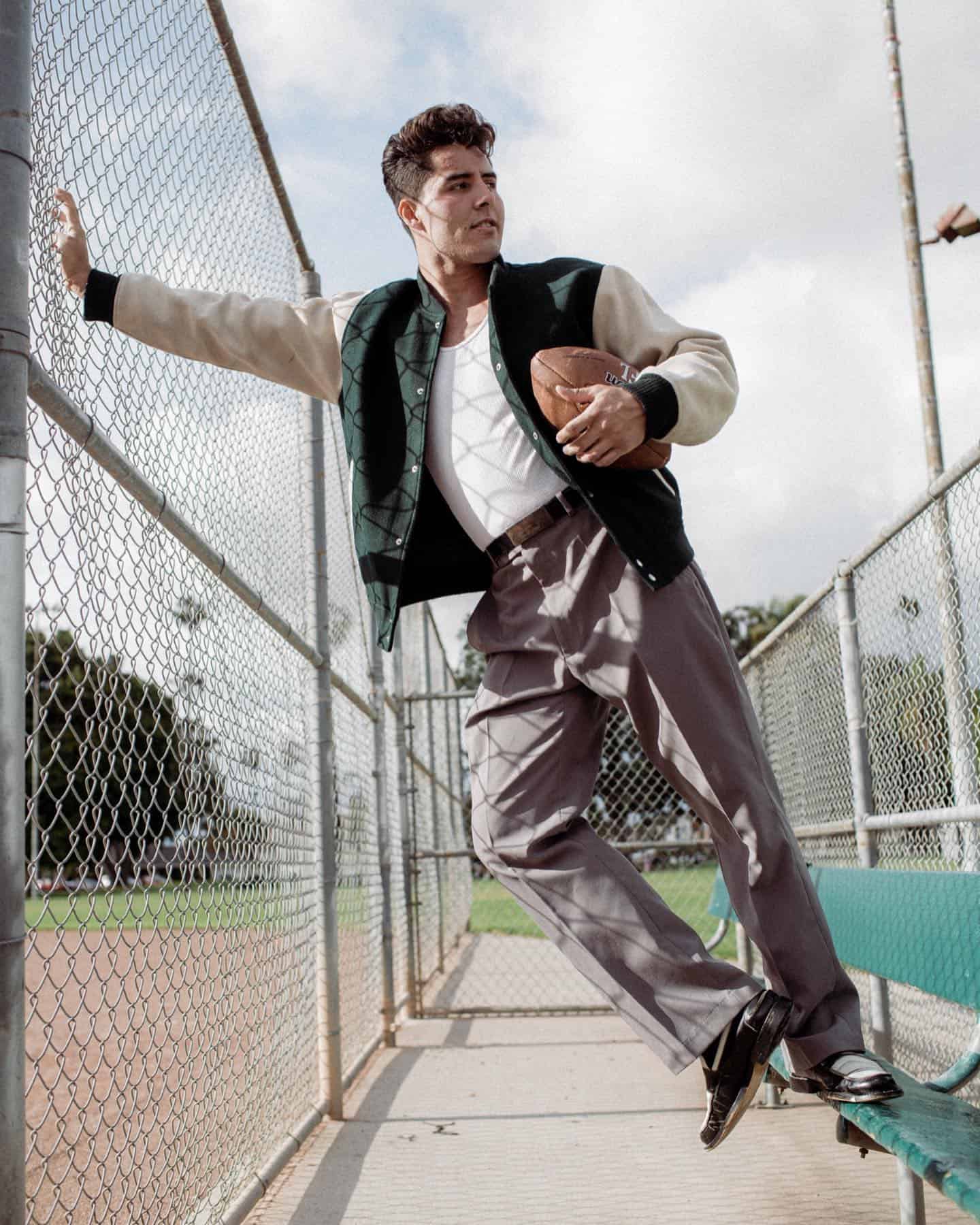
Pants
Trousers during the 1950s emphasized comfort and mobility, keeping with the loser cut of the previous decades. The cuff on the bottom of pants was very popular at the time, regardless of whether you were wearing jeans or trousers. The cuff was typically 2-4 inches, depending on height and personal tailoring.
The preferred pant style of men’s 1950s fashion was high-waisted, often single or double-pleated pants that provided a longer silhouette. Shorts or Bermuda shorts, around knee length, were also very popular, these were cut and designed just like dress-trousers or suit pants and featured bolder colors and plaid patterns.
Denim jeans began to emerge as a popular casual wear option, especially among the younger generation, inspired by Hollywood and the growing music scene. Chinos and khakis also gained popularity from the rise in preppy fashion for both casual or semi-formal occasions, offering a lighter, more versatile alternative to traditional wool trousers.
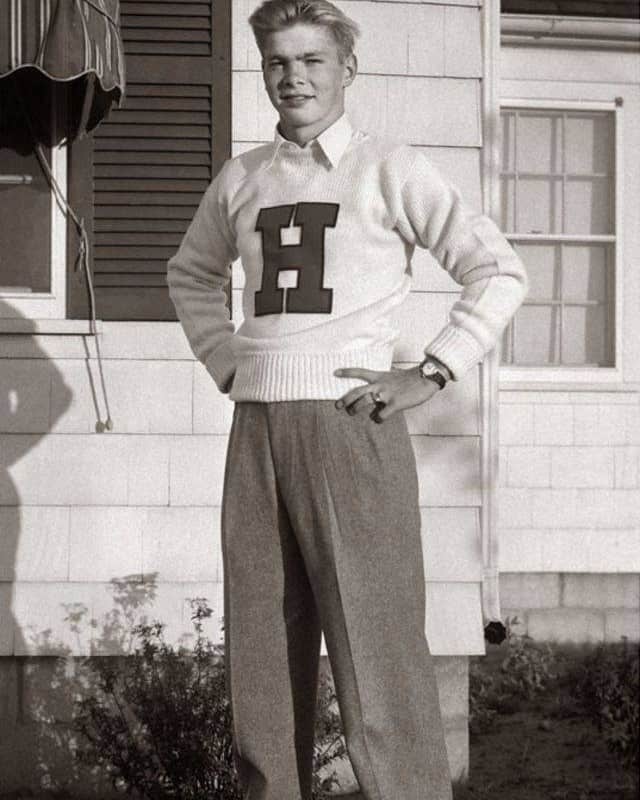
Sweaters & Knitwear
50s men’s fashion marked a significant period for sweaters and knitwear as essential components of a gentleman’s style, reflecting the era’s shift towards more casual and versatile clothing options.
Sweaters became popular for their comfort and practicality. They were often worn over shirts for a smart-casual look. The V-neck sweater, in particular, was a staple. It was easily paired with a collared shirt underneath and sometimes a tie, making it suitable for both office environments and casual outings.
The use of new synthetic fibers, alongside traditional wool, allowed for a wider range of styles and colors, making sweaters and knitwear more appealing and accessible to the everyday man.

Jackets & Outerwear
Outerwear and men’s jackets in the 1950s were characterized by diversity, splitting fashion trends and innovation, catering to both functional needs and fashion statements.
Cardigans, leisure jackets, and sport coats became symbols of the relaxed movement to men’s style. The teenage rebellion of the decade, thanks in part to Hollywood’s influence, saw the rise of leather motorcycle jackets and new emerging subcultures. The trench coat maintained its popularity from previous decades, serving as a stylish option for rainy weather, while the pea coat offered warmth and durability for colder months.
Outerwear in the 1950s not only provided practicality and comfort but also an opportunity for men to express their individual style and adaptability to changing social norms.

Footwear
Footwear in the 1950s saw a mix of traditional styles and emerging trends that reflected the decade’s diverse fashion landscape. Oxford shoes remained a staple for formal occasions, available in a variety of materials and finishes, including the ever-popular patent leather for evening wear.
The loafer, originally a casual shoe, gained popularity for its comfort and ease of wear. When crafted in finer leather, it became acceptable in more formal settings. The leather slipper became the replacement ‘house shoe’ of the era.
The introduction of the desert boot and the chukka provided a casual yet stylish option that paired well with increasingly popular casual wear, like chinos and jeans. Sneakers, like Converse (still popular today), once primarily seen as athletic wear, began to cross over into casual fashion, influenced by the youth culture and icons like James Dean.
The footwear choices of this era underscored the evolving nature of 1950s men’s fashion, balancing tradition with a growing appreciation for comfort, versatility, and personal expression.

Men’s Formalwear in the 1950s
Men’s formalwear in the 1950s continued to emphasize elegance and sophistication, with a focus on tailored suits and attention to detail that defined the era’s approach to formal occasions.
The tuxedo remained the gold standard for evening wear, featuring a single-breasted jacket with a shawl or peak lapel, often in black or midnight blue. The dinner jacket, in lighter fabrics and colors, offered a slightly less formal option for evening events, especially in warmer climates.
Formal shirts were typically white with a wingtip or turndown collar, accompanied by a bow tie or a slim necktie. Cummerbunds and waistcoats added a layer of refinement, while patent leather shoes completed the ensemble.
This period also saw the rise of bespoke tailoring, allowing men to personalize their formalwear with custom fittings and unique details, reflecting the importance of individual style even in the most formal settings.
![SMDR Photographic Negatives Collection, [1950s][Rattler Grid 1950 squad & men] by San Marcos Daily Record Negatives](https://cdn-fnknc.nitrocdn.com/jwqHRGAzpUgGskUSHlppNQzwuXgXIKwg/assets/images/optimized/rev-fabb85c/www.fashionbeans.com/wp-content/uploads/2024/02/1950sMensFashion_twoyoungmenin1950swearingjeansandtuckedinshirts.jpg)
Men’s Casualwear in the 1950s
The 1950s were a turning point for men’s casualwear, marked by an increasing desire for comfort, functionality, and personal expression outside the constraints of formal attire. The decade saw the rise of leisurewear, influenced by the booming economy, increased leisure time, and the influence of youth culture and Hollywood icons.
T-shirts became a staple, moving from underwear to a standalone piece, popularized by stars like James Dean and Marlon Brando. Denim jeans emerged as the symbol of casual and rebellious youth, thanks to their durability and comfort, paired often with leather jackets or casual button-down shirts for a complete look.
The introduction of the Hawaiian shirt in the ‘40s continued to add a colorful and exotic flair to men’s 1950s wardrobes, reflecting the era’s fascination with travel and leisure. Meanwhile, knit polo shirts offered a smart-casual option, bridging the gap between formal shirts and casual tees.
For footwear, canvas sneakers, leather boots, and loafers were favored for their comfort and versatility, complementing the casual look.
![SMDR Photographic Negatives Collection, [1950s][Rattler Grid 1950 squad & men] by San Marcos Daily Record Negatives](https://cdn-fnknc.nitrocdn.com/jwqHRGAzpUgGskUSHlppNQzwuXgXIKwg/assets/images/optimized/rev-fabb85c/www.fashionbeans.com/wp-content/uploads/2024/02/1950sMensFashion_twomenin1950swearingtshirtsandbaseballcaps.jpg)
Men’s Accessories in the 1950s
Hats
Hats maintained their status as an essential accessory for men in the 1950s, though their popularity began to wane as hairstyles became a more prominent feature of men’s fashion.
The fedora, with its wide brim and indented crown, continued to be popular among men seeking a sophisticated addition to their ensemble. The trilby, a shorter-brimmed variant of the fedora, offered a more casual look, suitable for both formal and leisure activities.
For more casual occasions, the flat cap, baseball hat, and newsboy cap provided a touch of working-class chic, reflecting the decade’s blend of styles from different social backgrounds.
Despite the decline in hat-wearing towards the end of the decade, these pieces remained symbols of elegance and were key to completing the well-dressed man’s outfit.
Watches
Watches in the 1950s were not just timekeeping devices but symbols of status and style. The decade saw the rise of luxury Swiss brands, with Rolex, Omega, and Patek Philippe leading the way in innovation and design.
Watches were typically mechanical, with manual or automatic winding, and featured elegant, simple designs with leather straps or metal bracelets. The popularity of dive watches and chronographs also increased, reflecting a growing interest in sports and outdoor activities.
Ties
Ties in the 1950s were an essential component of a man’s wardrobe, signifying professionalism and individualism – as ties were still seen as professional with wild and bold patterns. However, it was becoming more popular and still professional to go to work or events without one. The decade favored wider ties with pointed tips, reflecting a return to the bold styles of the pre-war era, with vibrant colors and elaborate patterns, including stripes, polka dots, and paisleys.
Silk, wool, rayon, polyester and even cotton knit were the materials used for ties of the era, offering a rich texture and sheen that complemented the era’s tailored suits. The bow tie also enjoyed popularity, especially pre-tied versions, offering a dapper and simpler alternative to the traditional necktie.
Suspenders and Belts
Suspenders remained a functional and stylish choice for securing trousers, favored for their classic appeal and comfort. However, as the decade progressed, belts became more popular, in part due to the increasing casualness of 1950s men’s fashion.
Leather belts, in particular, were seen as a more modern and versatile option, available in a variety of widths and finishes to complement both formal and casual attire.
Glasses
Glasses in the 1950s became a fashion statement beyond their practical purpose. The introduction of horn-rimmed glasses, with their distinctive thick frames, added an intellectual flair to men’s appearance. Metal-rimmed glasses and aviators were also popular, offering a sleek look.
Sunglasses gained in popularity, driven by Hollywood and the rise of outdoor leisure activities. Styles like the wayfarer and the aviator became iconic symbols of the era’s cool, casual aesthetic.
More Popular Accessories for Men in the 1950s
Beyond the essentials, men’s fashion in the 1950s embraced a variety of accessories to personalize and enhance their outfits. Scarfs were very popular in the colder season, often neatly tied and tucked under the collar of a coat.
Men’s jewelry, including signet rings and chain bracelets, began to gain acceptance, marking the start of a broader trend towards accessorizing in men’s fashion. These accessories not only complete the look but also allowed men to express their individuality and status in a rapidly booming and individualistic society.

Men’s Grooming Trends in the 1950s
1950s Men’s Hairstyles
The 1950s saw a variety of men’s hairstyles that reflected the decade’s mix of conservatism and emerging rebellious trends. The crew cut, and the Ivy League haircut was immensely popular for their clean, neat appearance, symbolizing the post-war return to traditional values. These styles were short, easy to manage, and suited the professional man.
On the other end of the spectrum, the pompadour and the quiff became symbols of the youthful rebellion, inspired by music and movie icons like Elvis Presley and James Dean. These styles featured longer hair on top, styled upwards and back for a dramatic effect, often using pomade to achieve the desired hold and shine.
The ducktail, another iconic style of the era, involved hair slicked back around the sides and brought together at the back of the head, resembling the rear end of a duck. This style, while less common in professional settings, underscored the growing influence of rock ‘n’ roll on fashion and culture.
Sideburns also made a comeback, growing in popularity towards the end of the decade, further illustrating the shift towards more expressive personal grooming.
1950s Facial Hair
Facial hair in the 1950s was generally kept to a minimum, with clean-shaven faces dominating the era’s grooming trends. This was in line with the decade’s emphasis on neatness and conformity, especially in professional environments.
However, the mustache saw a resurgence in popularity among certain groups, often worn thin and neatly trimmed, adding a touch of sophistication or ruggedness to a man’s appearance.
The goatee and the Van Dyke beard were also fashionable in artistic and bohemian circles, though less common in mainstream society. These styles allowed for individual expression within the constraints of the era’s grooming standards.
Grooming norms began to relax slightly in the late 1950s, setting the stage for the more varied and expressive styles of the 1960s.

Big Names in 1950s Men’s Fashion
1950s men’s fashion was shaped by a number of influential designers, celebrities, and cultural figures who left a lasting impact on the style world.
In the world of haute couture, designers like Christian Dior and Hubert de Givenchy began exploring men’s fashion, introducing tailored suits and refined casualwear that blended traditional craftsmanship with modern aesthetics.
The influence of Hollywood was undeniable, with actors such as Cary Grant, Gregory Peck, and Marlon Brando becoming style icons for their on-screen and off-screen personas. Grant and Peck epitomized the classic, timeless style with their impeccable tailoring and understated elegance, while Brando and James Dean introduced a more rebellious, casual look that resonated with the younger generation.
In music, Elvis Presley emerged not only as a cultural phenomenon but also as a fashion icon, popularizing bold and flamboyant styles that contrasted sharply with the conservative trends of the early 1950s. His love for flashy suits, leather jackets, and the pompadour hairstyle influenced countless fans and signaled a shift towards more personal and expressive fashion choices.
50s style also saw the emergence of influential photographers and magazine editors who helped shape public perceptions of fashion. Figures like Richard Avedon and Irving Penn captured the era’s looks in striking images that graced the pages of Vogue and Harper’s Bazaar, while editors like Diana Vreeland championed the integration of fashion and culture, setting the stage for the evolution of men’s style in the decades to follow.
How to Wear 1950s Men’s Fashion Today

Incorporating 1950s fashion into today’s wardrobe is about embracing classic style with a modern twist. Start with the essentials: a well-tailored grey flannel suit, a crisp white shirt, and a pair of polished Oxford shoes for a timeless formal look.
For casual wear, a pair of straight-leg selvedge denim jeans, a plain white T-shirt, and a leather jacket can capture the 1950s rebel spirit. Add a pair of loafers or canvas sneakers for a versatile look that bridges decades.
Accessorize with period-appropriate pieces like a fedora hat or a pair of horn-rimmed glasses to add authenticity to your outfit. However, the key is to balance vintage elements with contemporary fits and styles to avoid looking like you’re wearing a costume. Mix and match items from different eras and experiment with textures and patterns to create a look that’s both nostalgic and relevant.
Final Verdict
1950s men’s fashion was a decade of transformation, characterized by a blend of traditional elegance and emerging casual styles. Today, the era’s influence remains strong, offering timeless pieces that can enhance any wardrobe. By adopting the key elements of men’s 1950s fashion and adapting them to modern tastes, any guy can achieve a look that is both classic and contemporary, proving the enduring appeal of this pivotal decade in style. Continue on as we speed towards the tumultuous 60s and what excitements in men’s fashion lie ahead.
FAQ
-
-
In the 1950s, men wore a range of clothing from tailored grey flannel suits, crisp white shirts, and slim ties for formal occasions to casual wear like polo shirts, leather jackets, and denim jeans. The emphasis was on clean lines, quality fabrics, and a neat appearance.
-
Popular styles for men in the 1950s included the classic grey flannel suit for business and formal occasions, the leather bomber jacket and jeans for a more rebellious casual look, and the introduction of Hawaiian shirts and polo shirts for leisurewear.
-
While denim jeans became highly popular among young men in the 1950s as a symbol of rebellion and youth culture, jean jackets were not as prominently featured in men’s fashion until later decades.
-
Khakis and chinos were popular in the 1950s as part of the casual wear expansion, offering a versatile and comfortable alternative to formal trousers and perfectly fitting into the emerging casual, suburban lifestyle.
-
In the 1950s, attractiveness for men was characterized by a clean, well-groomed appearance, with a fit and tailored silhouette in clothing. Hollywood icons like Cary Grant and James Dean epitomized the era’s ideals of attractiveness through their polished and sophisticated formal wear or their rugged and casual rebel looks, respectively.
-







